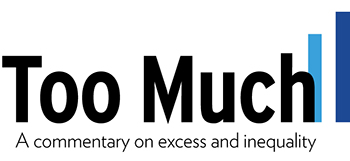The Great Recession, new research shows, has left wealth in the United States even more concentrated at America’s economic summit.
By Sam Pizzigati
Average American households have been riding an economic roller coaster over the last quarter century. The stock market has boomed and collapsed. Housing has boomed and collapsed. The entire economy has boomed and collapsed.
Where has this wild ride left the typical American family? Back to square one. And then back some more. The typical American household, as of mid 2009, held less in real net worth — that’s assets minus debts, adjusted for inflation — than the typical U.S. household held back in 1983.
But the even bigger story may be the reason why. New York University economist Edward Wolff tells that story in a new analysis of the Federal Reserve’s latest household wealth data research, just published by the Bard College Levy Economics Institute.
Federal Reserve researchers started collecting household wealth data in 1983, and the latest Fed numbers take us through 2007. Wolff takes us even further — to last July — by crunching more recent housing price and stock market stats.
Wolff’s numbers, covering over a year of recession, show “an astounding 36.1 percent” plunge in the household wealth of the median U.S. household since the economy’s 2007 peak. The wealth of America’s richest 1 percent? That’s dropped as well — but only by 11.1 percent.

Since 2007, in short, America’s richest 1 percent have done considerably better than average Americans. And that should be no surprise. Households in our richest 1 percent have been doing considerably better than average households ever since the Federal Reserve started keeping score a generation ago.
The key stat: Between 1983 and 2007, the wealth of America’s top 1 percent increased well over twice as fast as the wealth of the typical American family.
In effect, suggest Wolff’s new numbers, average Americans today aren’t hurting because the economy has stopped generating wealth. Average Americans are hurting because the wealth the economy is generating continues to cascade disproportionately to the top.
Between 1983 and 2007, as Wolff notes, the nation’s richest 1 percent took in over one-third of the nation’s total gain in marketable wealth, over triple the 11.2 percent that went to the bottom 80 percent of the nation’s households. And since 2007 the top 1 percent of the nation’s households have seen their overall share of the nation’s wealth increase from 34.6 to 37.1 percent.
Percentages like these can come across as awfully abstract. Wolff seems to understand that. To help us better grasp the wealth accumulation dynamic at work in the U.S. economy, Wolff supplies another set of more easily fathomable numbers. He counts millionaires, penta-millionaires (households worth at least $5 million), and deca-millionaires (households worth at least $10 million).
Between 1983 and 2007, the number of households worth at least $1 million, as measured in 1995 dollars, tripled, from 2.4 million to just under 7.3 million. Over that same span, the number of households worth over $5 million jumped by six times and the number worth $10 million by an even higher seven times.
To truly understand the roller coaster average Americans have been riding, Wolff’s analysis makes plain, we need to come to grips with the awesome inequality these numbers reflect. With so little of the nation’s wealth flowing into middle class pockets, average Americans have found themselves having to go deeper and deeper into debt to keep their heads above water.
 In 1983, the middle 60 percent of Americans had $2 of debt for every $3 of income. By 2007, these middle class Americans had nearly $5 of debt for every $3 of income. These rising debt ratios, observes Wolff, left middle class households “vulnerable to income shocks and set the stage for the mortgage crises of 2008 and 2009 and the resulting financial meltdown.”
In 1983, the middle 60 percent of Americans had $2 of debt for every $3 of income. By 2007, these middle class Americans had nearly $5 of debt for every $3 of income. These rising debt ratios, observes Wolff, left middle class households “vulnerable to income shocks and set the stage for the mortgage crises of 2008 and 2009 and the resulting financial meltdown.”
Wolff labels this vulnerability the “middle-class squeeze.” His numbers help us feel that squeeze’s strain. Maybe more importantly, his analysis helps us see what’s doing the squeezing.
Sam Pizzigati edits Too Much, the online newsletter on excess and inequality published by the Washington, D.C.-based Institute for Policy Studies. Too Much appears weekly. Read the current issue or sign up to receive Too Much in your email inbox.



This is an interesting take on economic inequality, but I see the explosion of middle class debt levels less as a symptom of a “squeeze” as you put it, and more as evidence of our tendency to over consume (i.e. failure to live within one’s means). The largest share of descretionary income is devoted to housing. The average family size has decreased by almost 25% over the last 30 years, but new house sizes have doubled during the same period. Can we not say more about fiscal responsibility of the middle class?